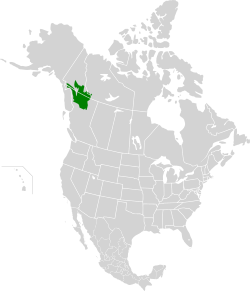Northern Cordillera forests
This article needs additional citations for verification. (April 2021) |
| Northern Cordillera forests | |
|---|---|
 Coniferous forest and deciduous shrubs along the Stewart–Cassiar Highway near Good Hope Lake | |
 | |
| Ecology | |
| Realm | Nearctic |
| Biome | Boreal forests/taiga |
| Borders | List
|
| Bird species | 165 [1] |
| Mammal species | 55 [1] |
| Geography | |
| Area | 262,884 km2 (101,500 sq mi) |
| Country | Canada |
| Provinces/territories | British Columbia, Northwest Territories, and Yukon |
| Climate type | Subarctic |
| Conservation | |
| Conservation status | Vulnerable |
| Habitat loss | 0%[1] |
| Protected | 11.6%[1] |
Northern Cordillera forests is a
World Wildlife Fund
(WWF) categorization system.
Setting
This ecoregion occupies a transitional region of mountains, valleys, and high plateaus between the Coast and Saint Elias Mountains to the west, and the Northern Rocky Mountains to the east.
Climate
This ecoregion has a predominantly subarctic climate (Köppen Dfc ) with cool summers and cold winters. Mean annual precipitation is approximately 350-600 mm, but increases up to 1000 mm at higher elevations. The highest elevations feature an alpine tundra climate.
Ecology
Flora
The lower mountains and valleys are dominated by
Fauna
Fauna found throughout this ecoregion include
Conservation
Some protected areas of this ecoregion include:
- Denetiah Provincial Park and Protected Area
- Kusawa Territorial Park
- Nahanni National Park Reserve
- Neʼāhʼ Conservancy
- Spatsizi Plateau Wilderness Provincial Park
- Tā Chʼilā Provincial Park
See also
References
- ^ a b c d "The Atlas of Global Conservation". maps.tnc.org. Archived from the original on 2012-03-05. Retrieved 2020-10-28.
- ^ a b "Northern Cordillera forests | Ecoregions | WWF". World Wildlife Fund. Retrieved 2020-10-29.
External links
Wikimedia Commons has media related to Northern Cordillera forests.
- "Northern Cordillera forests". Terrestrial Ecoregions. World Wildlife Fund.
